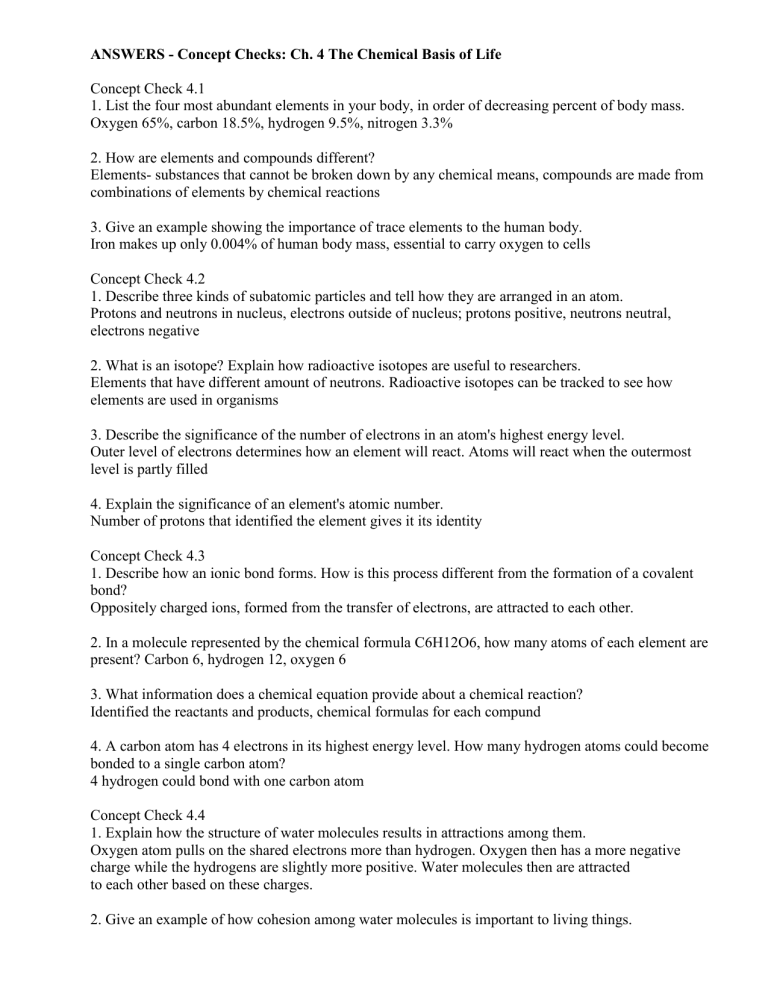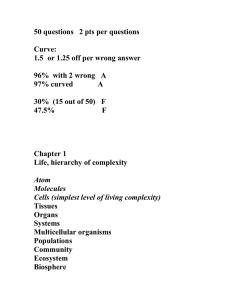ANSWERS - Concept Checks: Ch. 4 The Chemical Basis of Life

ANSWERS - Concept Checks: Ch. 4 The Chemical Basis of Life
Concept Check 4.1
1. List the four most abundant elements in your body, in order of decreasing percent of body mass.
Oxygen 65%, carbon 18.5%, hydrogen 9.5%, nitrogen 3.3%
2. How are elements and compounds different?
Elements- substances that cannot be broken down by any chemical means, compounds are made from combinations of elements by chemical reactions
3. Give an example showing the importance of trace elements to the human body.
Iron makes up only 0.004% of human body mass, essential to carry oxygen to cells
Concept Check 4.2
1. Describe three kinds of subatomic particles and tell how they are arranged in an atom.
Protons and neutrons in nucleus, electrons outside of nucleus; protons positive, neutrons neutral, electrons negative
2. What is an isotope? Explain how radioactive isotopes are useful to researchers.
Elements that have different amount of neutrons. Radioactive isotopes can be tracked to see how elements are used in organisms
3. Describe the significance of the number of electrons in an atom's highest energy level.
Outer level of electrons determines how an element will react. Atoms will react when the outermost level is partly filled
4. Explain the significance of an element's atomic number.
Number of protons that identified the element gives it its identity
Concept Check 4.3
1. Describe how an ionic bond forms. How is this process different from the formation of a covalent bond?
Oppositely charged ions, formed from the transfer of electrons, are attracted to each other.
2. In a molecule represented by the chemical formula C6H12O6, how many atoms of each element are present? Carbon 6, hydrogen 12, oxygen 6
3. What information does a chemical equation provide about a chemical reaction?
Identified the reactants and products, chemical formulas for each compund
4. A carbon atom has 4 electrons in its highest energy level. How many hydrogen atoms could become bonded to a single carbon atom?
4 hydrogen could bond with one carbon atom
Concept Check 4.4
1. Explain how the structure of water molecules results in attractions among them.
Oxygen atom pulls on the shared electrons more than hydrogen. Oxygen then has a more negative charge while the hydrogens are slightly more positive. Water molecules then are attracted to each other based on these charges.
2. Give an example of how cohesion among water molecules is important to living things.
Causes water molecules to be attracted to each other. Helps water flow upward from roots towards leaves.
3. Describe the information the pH scale provides.
How acidic or basic a solution is
4. Name three conditions on Earth that make the planet suitable for life.
Abundance of water, distance from sun, presence of essential elements
5. Explain one way in which water can moderate temperature.
Large body of water absorbs heat energy during day, and releases it at night – warming the nearby air and land











